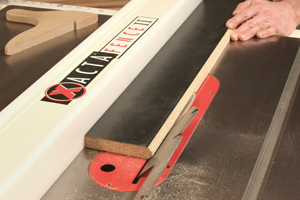
What is the reason in selecting a table saw with a left- or right-tilting blade? Is there a particular reason for one, or is it a matter of personal choice and what one is used to? I am in the market for a new (to me) table saw and would like to be better informed. – Greg Herrick
Tim Inman: Left or right? Well, my view is that this is largely a matter of personal choice and budget. There are reasons to select either one.
My saws are left-tilting. I’m right-handed, and I prefer the blade to tilt to the left. With this configuration, when I want to cut a bevel on the edge of a board, the rip fence is on the right side of the blade. I naturally apply pressure toward the fence as I guide the wood through the blade. Yes, this means my arm is reaching out across the blade’s line of cut. But to me, it is a good and safe trade-off because the default is to press into the fence, not into the blade. My professors might have disagreed. They liked the whole opera to be played such that if anything went wrong, there was a fence between the works and the operator. This is not only uncomfortable and contorted, I think it is distracting. Anything that distracts the operator while using a table saw is bad. With a left-tilting blade and the rip fence on the right side of it, the cutoff is not trapped underneath the saw blade! Using either left or right tilt, it is dangerous to tilt the blade and set the fence in such a way that the cutoff is trapped underneath the blade next to the fence. This is another way to make an arrow out of a board — often at an unwanted and unexpected moment! Think about kickbacks.
Cabinet saws are more expensive, and are usually left-tilting. The arbor nut that holds the saw blade onto the shaft is usually a left-handed nut on a right-tilting saw. Having a left-handed thread on anything can be confusing; not a dealbreaker, but an issue to think about. There are some other things that may be important to you. Measuring from the saw to the fence is more convenient with a left-tilting blade — at least to a right-hander. The side of the saw where you’ll find the tilting wheel might be important. Is the motor on the side or in the back? Does this make a difference? If you’re wanting to add on a big extension table behind the saw so you can handle sheets of plywood by yourself, then having a motor back there is a problem. I’d rather have the motor off to one side.
So, you can see — the choices become personal and particular to a given setup and budget. Any saw will make the same cuts. Any saw can be dangerous. If used wisely and with skill, every saw can be used safely and accurately — and will give a lot of pleasure in the work.
Chris Marshall: I think this is largely a matter of personal preference. There are far more left-tilting table saw models these days than right-tilt saws, across the category — jobsite, contractor, hybrid and cabinet, and here are a couple of plausible reasons why that is. A left-tilting saw with an extension table on the right side will give you more working room on the right for crosscutting long workpieces or working with large sheet goods. The arbor will also be oriented to the right and threads clockwise — very convenient for right-handed users. Since most of us position rip fences to the right of the blade, the blade tilts away from the fence instead of toward it, which is a safety concern when bevel-ripping. The blade should never “trap” a workpiece underneath it and against the fence. A kickback could occur if an offcut jambs in this tunnel and the blade catches it





